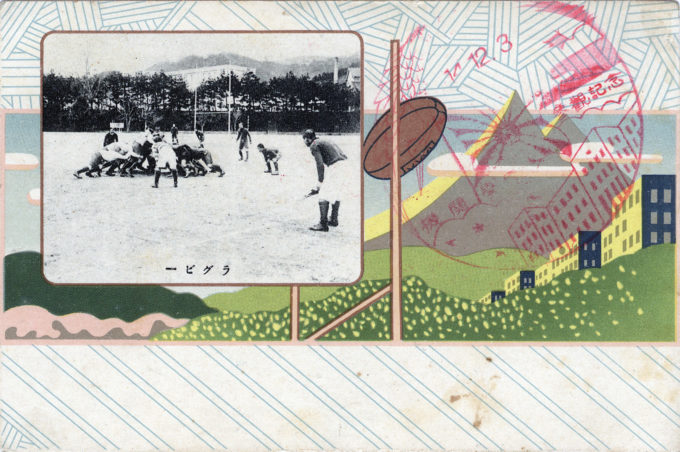
“Rugby”, Naval Engineering College, Yokosuka Naval Arsenal, 1939. In the epic 1942 Japanese war film, The War at Sea from Hawaii to Malaya, rugby was shown as being a part of the basic training for cadets in the Imperial Japanese Navy.
See also:
Keio University baseball players on the field, c. 1910.
The 6th Far Eastern Championship Games advertising postcard, 1923.
Otokonoko (“young boy”) sumo “wrestler”, c. 1910.
Rugby was first introduced to Japan in the treaty ports around 1866, with the establishment of the Yokohama Foot Ball Club, where games were primarily played between British service personnel.
The sport gained significant traction when it was brought to Keio University in 1899 by Japan-born Englishman Professor Edward Bramwell Clarke, who taught his students the game, giving Keio bragging rights as the birthplace of Japanese rugby; Japan’s first recorded international match was against a Canadian team in 1932.
Before the arrival of rugby, Japan was home to a game known as kemari. Introduced to Japan from China in about 600 AD, kemari was based upon the Chinese sport of cuju. The object of kemari is to keep one ball in the air, with all players cooperating to do so.
Rugby union football, aka “rugby union” or often just “rugby”, is a close-contact team sport that originated at Rugby School in England in the first half of the 19th century.
The rules committee of the Yokohama club consisted of notable Rugby School, Radley and Winchester College alumni. Games, mainly between Royal Navy sailors stationed there or who were temporarily berthed in the port on shore leave, were played on the Garrison Parade Ground in Yamate, Yokohama.
The date of local Japanese participation in the sport is most frequently cited as 1899, when students at Keio University were introduced to the game by Professor Clarke (who’d been born in Yokohama in 1874) and Ginnosuke Tanaka. Both Clarke and Tanaka were graduates of Cambridge University.
The growth of Japanese rugby in the early 20th century at the height of the Anglo-Japanese Alliance was rapid — by the 1920s, there were nearly 1,500 rugby clubs and more than 60,000 registered players, which meant that the sport had a larger presence in Japan than that of Scotland, Wales and Ireland combined.
Despite these extremely impressive figures, Japanese rugby was still isolated, and to an extent insular until after 1945. The first rugby tours by foreign teams to Japan did not occur until the 1930s.

